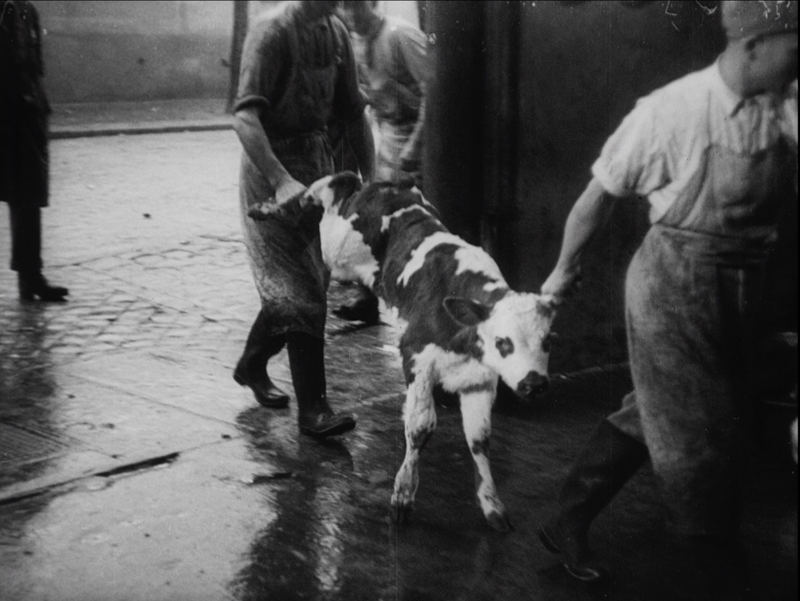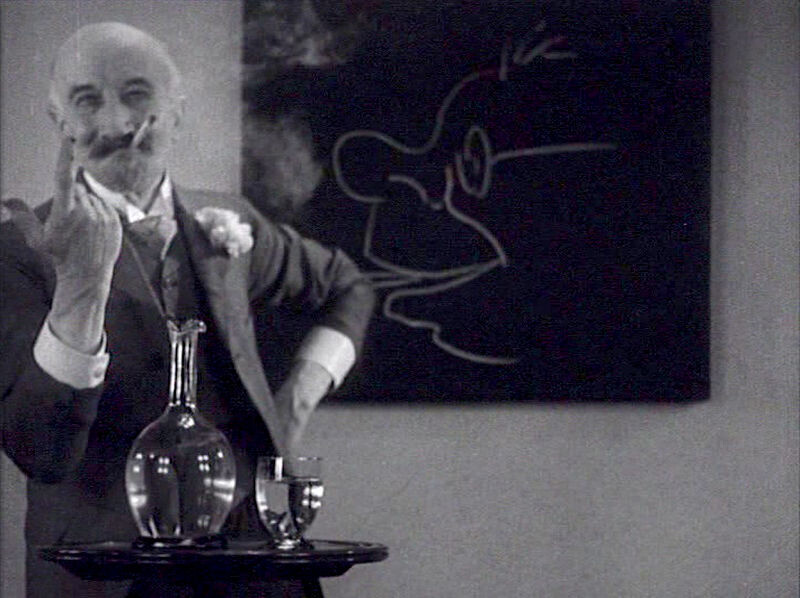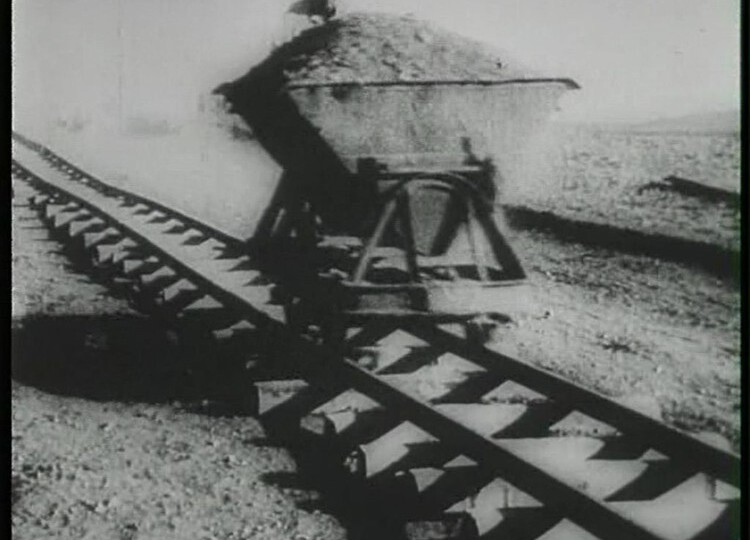In-depth explorations of raw reality
When making films the surrealists rejected from the outset the pseudorealistic and psychologizing approaches that had made film an artificial and anecdotal means of narration and a two-dimensional imitation of theater and the novel. They also spurned the artistic experiments of “integral” and “purist” avant-garde filmmakers (Abel Gance, Carl Theodor Dreyer, Jean Epstein, Marcel L’Herbier, Louis Delluc, Germaine Dulac, Fernand Léger, Jean Cocteau), who in their view had reduced cinematic language to formalist or visual games whose “affected and showy” effects they considered to be empty and formulaic.
The surrealists rejected purist and abstract cinema in favor of objective and natural cinematic tools. In their view, abstract cinema removed film from raw reality and the objective beauty of everyday life, which film is capable of revealing to thus provide a complete picture of reality, its manifestations, and its latent contents. In fact, it was by reproducing these most documentary aspects of the surrounding world that the illusionist apparatus (the cinematograph) managed a synthesis of seemingly antithetical elements – reality and imagination, consciousness and unconsciousness.
What captivated the surrealists was not documentary film’s educational potential, but its ability to capture ordinary and insignificant things and situations and to reshape them using the “magic” of cinematic technology and the audience’s imagination. Thanks to its documentary nature, film is capable of capturing “everyday miracles.” As Antonin Artaud said: “It is certain that every image, even the driest and most banal, becomes transformed when on the screen. The smallest detail, the most insignificant object takes on a life and a meaning belonging to it alone – and this is independent of the significative value of the images themselves…” As early as in 1918, Louis Aragon had celebrated the “modern magic” of film, whose realistic and documentary possibilities enabled it to reveal the beauty of the most ordinary places or objects and lend them an unexpectedly suggestive force: “Before the invention of the cinematograph, artists would hardly dare to work with […] the obsessional beauty of advertising signs, posters, suggestive type and objects intended for everyday use –all the things that sing the praises of our lives.”
This fascination with reality, whose presence film intensifies in an almost hallucinatory manner, enables film to reveal what Artaud called the “skin of reality” or the “human skin of things” – i.e., the material envelope that covers immobile objects and imbues them with life.
It is this poetic and emotional power of documentary film, its ability to reshape materials and details, and last but not least its animistic force, that the Parisian surrealists admired in the scientific and naturalist films of Jean Painlevé (La Pieuvre, 1928; L’Hippocampe, 1934; Le Vampire, 1943). In its combination of raw reality with the unreal and artificial, the surrealist approach comes close to that of Georges Franju in The Blood of Beasts (1949).
The documentary format also makes it possible to capture and highlight the “everyday miracles” of the urban environment, random encounters on the street, the modern poetry of shop windows and shop signs as in the photographs of Eugène Atget, which the surrealists rediscovered many years after they were taken. The miracles of the city also appear in André Sauvage’s documentary Etudes sur Paris (1928) and Jean Vigo’s À propos de Nice (1930). Several surrealists created “cinematic walks,” as for instance Marcel Duhamel and the Prévert brothers in Souvenirs de Paris (1928). The surrealist Jacques-Bernard Brunius, who had close ties to the “Rue du Château group” (which included the Prévert brothers, Marcel Duhamel, and Yves Tanguy), was actively engaged in film and made several documentaries. His compilation film Records 37 (1937), with narration by Robert Desnos, was an innovative experiment with the synchronization of image, words, sound and music, based on analogy and contrast. These efforts paved the way for a new kind of experimental film that existed in opposition to the artistic avant-garde’s “abstract” and “purist” films from the early 1920s. Here, the specificity of scenes from contemporary life stood in contrast to the cheapness of abstraction or concept. Another project to set out in this direction was La Revue surréaliste filmée, made using old bits of newsreel footage found at a Paris flea market in the early 1950s and compiled by Jindřich Heisler and Georges Goldfayn.
Brunius’s second documentary film, Violons d’Ingres (1939) – in which Brunius introduces Ferdinand Cheval and his “Ideal Palace” – presaged the surrealists’ interest in self-taught artists and “art brut.” Several years later, the surrealist Ado Kyrou explores the same subject in his short film The Ideal Palace (1958). Also working in this spirit were the French surrealists Michel Zimbacca and Jean-Louis Bédouin with their 1952 film L’Invention du monde, an important documentary film dedicated to primitive and Oceanic art, with a text written by the poet Benjamin Péret. Similarly, director and anthropologist Luc de Heusch, who had close ties to the Belgian surrealists and the COBRA group, filmed several documentaries about his artist friends under his real name and the pseudonym Luc Zangrie.
The best-known surrealist director, Luis Buñuel, also attempted to combine the expressive and objectivizing potential of documentary images with imaginary scenes. The prologue to his legendary film The Golden Age (1930) consists of a mini-documentary about scorpions. His third film, Land Without Bread (1933), is entirely documentary and yet profoundly infused with the surrealist spirit. Several parts of his feature-length fiction film Los Olvidados (1950) have a documentary origin. In this film, Buñuel tried to surreptitiously combine “social documentary and realism” with bizarre dream sequences in order to demonstrate that, for surrealists, the accurate or “documentary” analysis of reality cannot be separated from their dreamlike vision.
*
A similar approach can be found with Czech (Czechoslovak) surrealism in its understanding of film as a medium that provides a singular way of penetrating beneath the surface of external, objective reality in order to find its hidden meanings and motivations. Although the prewar surrealist group did not directly create any film projects, Karel Teige published numerous essays on film theory and the photographs of Jindřich Štyrský and Vítězslav Nezval (later also Miroslav Hák) exploring the bewitching nature of real neighborhoods and metropolitan suburbs shared an affinity with the aforementioned imaginative “cinematic walks and reportages”, which Alexander Hackenschmied concurrently and perhaps most pertinently developed in Aimless Walk (1930). In fact, this latter film’s collage-style vocabulary inspired Vratislav Effenberger and Josef Istler’s postwar surrealist film Study of a Fragment of Reality (1947), which unfortunately has not been preserved. This line of “civil imagination” loosely inspired Jiří Gold’s aggressive documentary Rafel mai amech izbai almi! (1969), which possesses a distinctive critique of civilization.

Le Sang des bętes (Georges Franju, 1949)
Other impulses for a connection between Czechoslovak surrealism and film appear independently from one another in the 1960s in the works of two protagonists of the New Wave – Karel Vachek and Jan Švankmajer. Vachek works on a purely documentary basis, although in an entirely unconventional manner. His use of sarcasm or imaginative short visual-semantic associations is fully in line with the era’s critical exploration (also found with the artists around Vratislav Effenberger) of “raw reality” as a feature and symbol of an absurd and grotesque world. This applies especially to Vachek’s films Moravian Hellas (1963) and Elective Affinities (1968). Besides his primarily fantastical projects, Jan Švankmajer – at first intuitively, and later (in the 1970s) quite programmatically as a member of the surrealist group – developed the critical combination of documentary elements and real-life motifs with imaginative elements and creative approaches whose semantic levels amplify one another to create what were usually darkly humorous parables on the crises and dangers of the self-absorbed world around us – as in The Garden (1968), Leonardo’s Diary (1972) and several others.
The short films of Ludvík Šváb, a longtime member of the surrealist circles, combine a seemingly naive amateur approach with an insider’s ironization of codified cinematic vocabulary. At the same time, in their documentary aspect they present the movement’s protagonists as participants in an intimately shared fate.
The most recent experimental works of Jan Daňhel and Martin Ježek unambiguously exceed the purely formal limits of cinematic expression in favor of a distinct and often para-documentary presentation of events, actions, situations or settings whose inner dimensions or unclear context are confrontationally renamed or redefined using non-rhythmic repetitive editing or other techniques.


